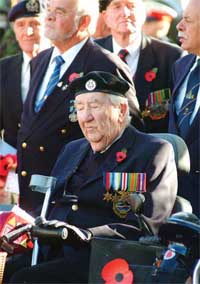|
Sunday, 8
November, will see the annual Remembrance Day service at
Whitehall’s Cenotaph.
Although the Treaty of Versailles that ended the Great
War was signed on 28 June 1919, the Allied powers have had an
armistice with Germany in place since 11 November 1918 and the
Sunday previous to that date usually sees memorial services held
around the world. So, as with every November, our thoughts turn to our fallen British and Commonwealth service personnel and the many that have been wounded in action or who are in action all over the world as you read this. The Royal British Legion has, for many years, helped and supported these service personnel and their families and is just as poignant today as we hear and see those brave men and women coming back from Afghanistan. This is a story about some of those people from 1942… "Even though the battle of the skies had been won by the RAF, there was still a big challenge for Churchill and the Royal Navy to win the Battle of the Atlantic, thus protecting the supply lines from North America. The German warship Tirpitz was Hitler’s jewel in the crown and in January 1942, was hiding up in the Kiel Canal in Norway. Churchill knew that at some stage, the vessel would need to be re-armoured and modified to go into out-and-out battle. Also, should the battleship need repairs from battle combat, it would need somewhere to go. The only dry dock capable of holding such a huge vessel was at St Nazaire on the French Atlantic coast. So plans were made to destroy the dry dock gates. Churchill needed to neutralise the threat of the mighty Tirpitz before she got to France. Under the command of Earl Louis Mountbatten, a plan was hatched to sail up the Loire in a |
REMEMBERING REMEMBRANCE DAY |
|
 ship laden with explosives, then ram and blow up the dry dock gates with submarine support. It was decided to use delayed action fuses, which would allow the British forces to escape first and hopefully reduce casualties. The ship to be used in the mission was the USS Buchanan, which had been given to the British by the USA and renamed HMS Campbeltown. For this mission, she was totally stripped and her bridge given armour plating. On the 26 March 1942 at 3pm and under the command of Capt Robert Ryder, HMS Campbeltown set sail from Falmouth on this daring and dangerous mission, with a gunboat and two destroyers as escort. They reached the mouth of the Loire around midnight that evening and proceeded towards St.Nazaire port. The port and estuary were heavily defended and to put off the German gunners, each ship flew a Nazi Ensign flag. Some two miles and 5 minutes from the target, the German flags were replaced with white British ensigns and the Germans opened fire with the ships crew suffering many casualties. The Campbeltown increased its speed significantly and rammed the dry dock gates at 01.34 on the 27 March - amazingly just 4 minutes behind schedule. Capt Ryder went |
ashore to satisfy himself that
the HMS Campbeltown was both scuttled and embedded in the gates.
He and his men then withdrew. On the way out, the fleet suffered
heavy loses and by the time they got back to Falmouth, only 4
boats of the 18 had survived. Of the 241 commandos that set off,
59 were killed or missing, 85 Royal Navy personnel were killed
or missing and many were captured. In all, 168 people lost their
lives with countless injured. The bravery of those men during
that operation was clear when 5 – including Captain Ryder - were
awarded the Victoria Cross, the most ever awarded in a single
operation. 70 bravery awards were given to other servicemen. The HMS Campbeltown was still embedded in the dry dock gates when 40 German officers came to have a look at the ship, along with two captured British Commando officers who knew about the explosives. The Nazi officers had been heard to remark that the British should have known that a ship this size could never had done such damage to the dry dock by ramming it. Little did they know because at 10.30 on 28 March, HMS Campbeltown exploded killing them, along with 250 German troops on the quayside. The dry dock gates were also irreparably damaged. Operation Chariot had rendered Hitler’s Battleship Tirpitz useless and made sure that the Allies took one more step closer to winning the Second World War." Please support the Royal British Legion, for Service personnel from yesterday and for those of tomorrow. Lest we forget, please wear your poppy with pride… Richard Potter (T51) |
|
|
|
Powered by NetXPosure |
| Copyright 1997-2009 Dial-A-Cab Ltd, All rights reserved. |